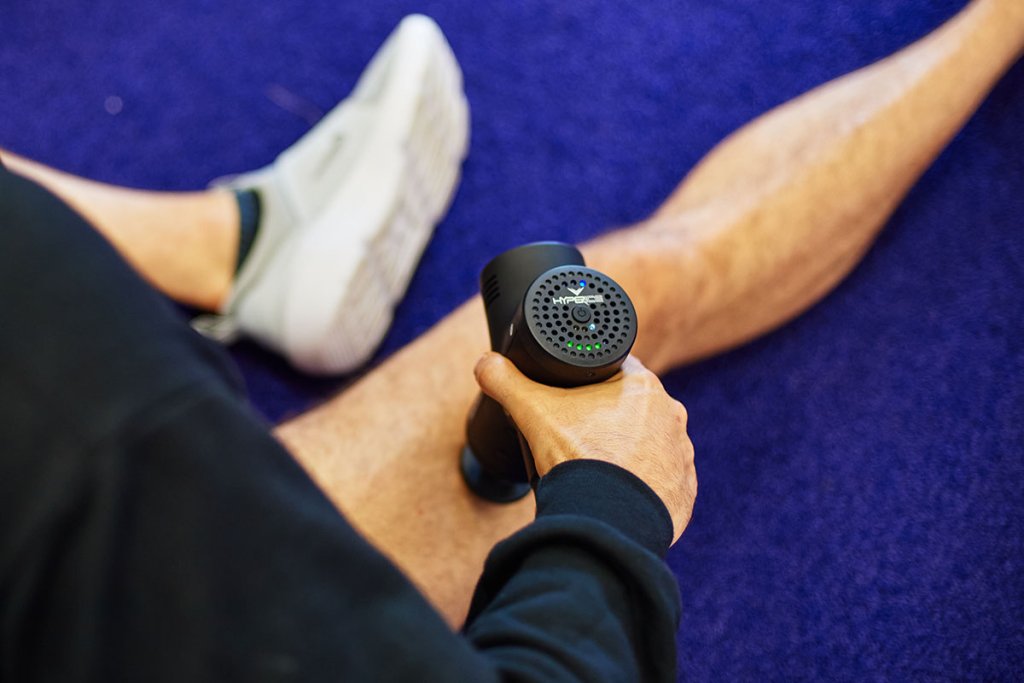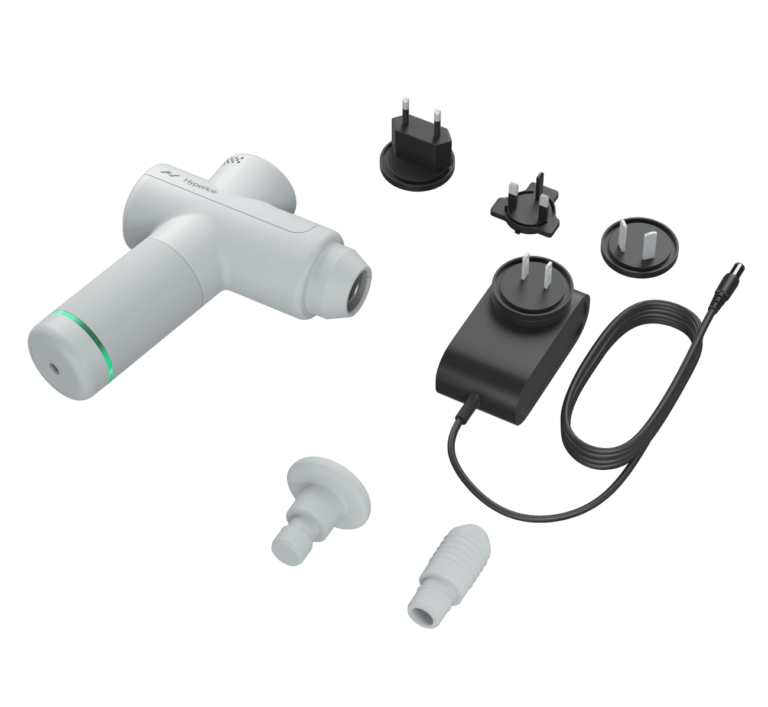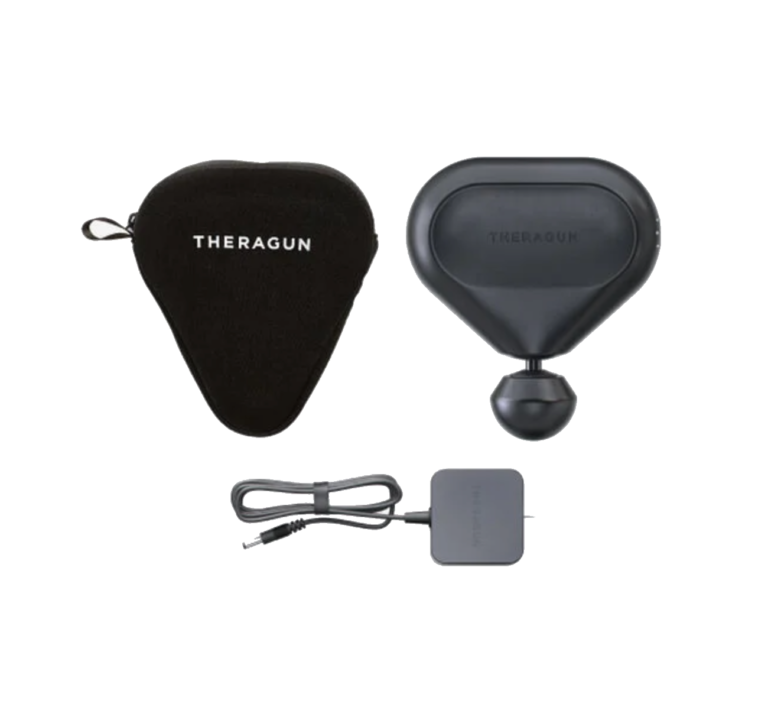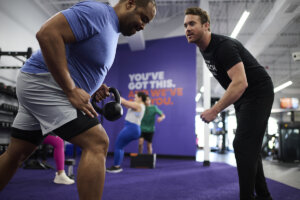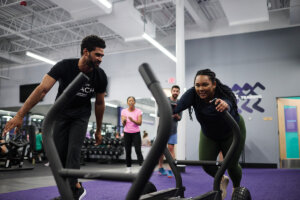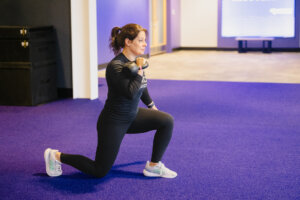Have you heard the buzz around your gym lately? Like, an actual buzz, or is it more of a hum? Percussion devices are all the rage and they are popping up in fitness settings, so let’s discuss what they are and how they work!
Percussion tools are amazing for relieving sore and/or tight muscles. They can also be used before and after workouts to help enhance performance and boost results! While the use of a percussion device might be great for one person, they aren’t for everyone, so we’ll also break down scenarios and situations you’ll want to skip the vibes and stick to stretching.
What are percussion devices and what do they do?
Percussion devices that are on the market today are handheld, often with interchangeable knobs for different percussive effects. They range in power level from 17 to 53 hertz or 40 to 90 Watts (from around 1,800 to over 3,000 percussions per minute). In other words, they pound at speeds from low to WHOA! There are options for light, daily use as well as upgraded –versions that are larger and sometimes come with more options (such as 5 speed settings instead of 2, or having a more powerful motor).
These devices are beneficial because they provide relief to sore muscles, and can even help prevent sore muscles in the first place! That’s something we can get behind! Additionally, percussion tools can help increase mobility and range of motion, helping you move better and with more fluidity. Gotta love that! How do these devices work? Read on!
How do percussion tools help with muscle recovery?
Using a percussion device on your muscles helps relieve soreness and tension in two ways. First, as you might suspect, the use of these tools (which pound your tissues at thousands of percussions per minute) causes actual motion in your skin, fascia and muscles. The percussion brings in more blood flow and helps reduce inflammation. In this way, the percussion tool is mechanically affecting your body in ways you can really feel. Additionally, the sensations felt by your central nervous system also help relax the signals being sent from your brain to your tissues, causing your body to literally relax from the inside out. A double whammy!
What are common percussion tools on the market?
There are two major manufacturers of handheld percussion devices, Hyperice and Therabody. Hyperice makes the Hypervolt models, and Therabody makes the Theragun models. In a survey of 425 practitioners in the health and fitness industry, 92% of those that use percussion tools choose from these two companies.
The differences between the two models come down to personal preference!
Our Coach’s Pick
We love the Hypervolt 2 Pro because of the five options for speeds! Many models have two options for speed, “low” and “high” but with the Hypervolt 2 Pro, you can get dialed in at the perfect intensity for your needs. This model comes with 5 attachments, including the “fork” which feels amazing when used up and down the spine.
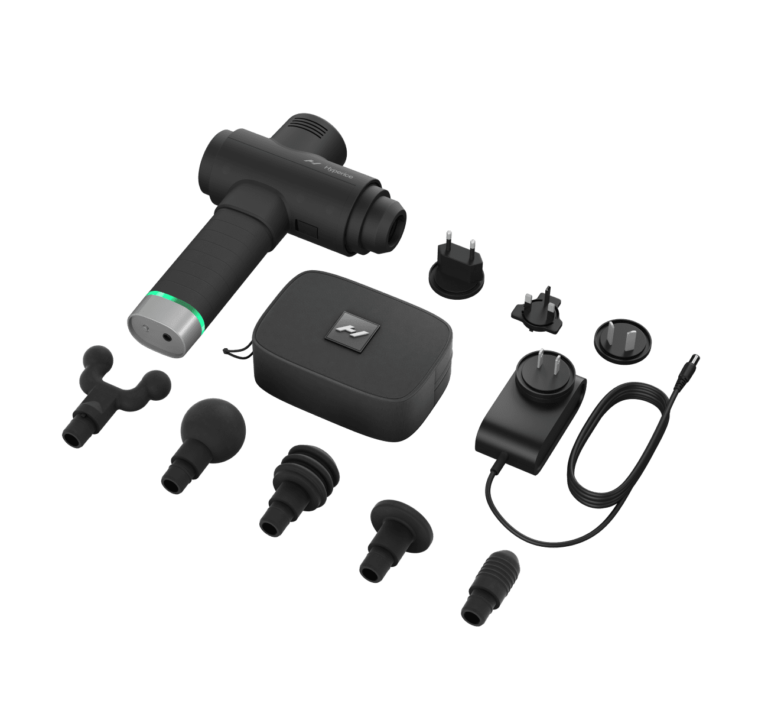
When is percussion the most effective?
They say that “timing is everything”…when it comes to using a percussion tool for muscle recovery, it couldn’t be more true! There are optimal times to whip out your Hypervolt to get the optimal benefits. Let’s break it down.
Pre-activity warm-up
Some people opt to get their muscles going before activity by using the Hypervolt as part of the warm-up routine. Combine dynamic stretches with 30 seconds to 1 minute of percussion on the muscle groups you plan to use in your workout. This helps increase blood flow and mobility to those areas. Win!
Post-activity recovery
Similar to pre-workout use, post-workout percussion on the muscle groups used in your workout will help with recovery. But how? Remember that percussion promotes blood flow, and when you are in a post-workout state, your blood is rich with oxygen and nutrients to fuel your tissues.
This is the optimal time to bring blood to those areas (luckily, your circulatory system takes care of this 24/7, but the percussion tool certainly helps by adding a little boost!) Use the Hypervolt on the target areas for 30 seconds to 1 minute each. Want to make sure you’re really maximizing this magic timeframe? Peep our Ultimate Post-Workout Checklist — your body will thank you!
To relieve DOMS (soreness)
Ever had a workout that you could feel the next day, even two days later? No matter how hard you try, you simply can’t forget about that workout– every time you move a muscle, you are reminded that those areas are still in recovery! Yowsa!
What you are experiencing is called DOMS or delayed onset muscle soreness and, well, the name really explains it all. The soreness sets in, but not until later, when your tissues have cooled down and you’ve moved on with your life (or tried to, at least!). To help relieve DOMS, use a low setting for 1-2 minutes on the affected areas. Deep breaths!
To relieve tension
Sometimes muscles aren’t necessarily sore, but they are certainly TIGHT. Similarly, our joints can sometimes hold tension. Let’s face it, our body tissues get stuck in their ways and need a little love to get moving again. Using a foam roller is fantastic for relieving tension and addressing tight spots, but adding percussion brings self-myofascial release to a new level.
The stimulation can help break up trigger points or “knots” in the myofascia (the layer of tissue that surrounds your muscle). Tension often lives in the myofascia, not the actual muscle itself, and applying percussion for 1-2 minutes on tight areas can help you feel loosened up.
How do you use a percussion tool?
Sweep
To do a sweep, move the device back and forth from left to right (or top to bottom) of the target area, spending a few seconds on each side–to–side sweep. For example, if you are using the tool on your calf, move up and down the length of the muscle from knee to ankle, and back again, repeating until you find relief.
Drill
When the tool is held for a longer duration (30-60 seconds or more) on one spot, this is called a drill technique. Keeping the percussion on a single area, and even turning up the intensity, can provide a deep-tissue focus to spots that hold tension.
Clock
A technique that is useful for areas that need attention but might be very tender is the clock. This involves applying percussion around a focus area in a clockwise or counter-clockwise pattern. It can help to address the tissues surrounding a sore area before tackling the target itself.
Percussion + Motion
In the techniques listed above, the device is moving but your body is not; instead, you’re relaxing the target area to allow the percussion to be effective. You can also add motion to the sweep, drill or clock techniques to target deeper tissues such as those inside joints or under the shoulder blades (a common place for tightness to hang out!)
To visualize this, imagine using the percussion device on your calf muscle but also flexing and extending your toes. Another example is applying percussion to your back while doing an arm circle at the same time. As your muscles and joints move, they absorb the percussion in different areas, making the experience more effective.
When should percussion be avoided?
While the use of percussion devices is not dangerous to the general public, there are certain situations in which you should avoid them. These recommendations are similar to those for other myofascial release techniques such as foam rolling and come from a research study which can be found here.
Avoid using percussion tools if you are experiencing any of the following conditions:
- Skin rash or open wounds
- Bone concerns such as osteoporosis
- Recent bone injuries
- Neurological conditions such as multiple sclerosis
- Diabetes
- Deep vein thrombosis
- Pain or discomfort in the area
- Cancer
- Viral or bacterial infection
- Fever or contagious condition
- Bleeding disorders (e.g. hemophilia)
- Medications that alter sensation or thin blood
- Recent surgery or tissue injury
- Sensitivity to vibration, percussion or sounds
Tips for Coaches
More often, percussion devices are making their way into fitness settings, and for good reason! As we have shown, before and after workouts are fantastic times to bust out the Hyperice and get the blood flowing. Without a doubt, adding a percussion device to exercise programming is going to be a value-add for your clients, but before you use a percussion device on anyone other than yourself, read these tips for fitness professionals.
Check state and local regulations
Percussion tools may be classified for use only by licensed personnel, so make sure to check state and local regulations to make sure there are no restrictions for use in a fitness setting. Some fitness organizations in various states require special licensing, so cover your bases by checking in your area first.
Know your client
Once you confirm you have the proper credentials to use a percussion tool on a client in a fitness setting, the next thing to do is make sure that they do not have any contraindications, or reasons why NOT to use the tool. While you personally may not have any conditions listed above, it’s your client that is of concern. You may consider the use of a pre-participation questionnaire or a liability waiver.
Clean regularly
This may go without saying, but just so we are clear—any equipment that is being used on multiple people needs to be properly cleaned between uses. At a minimum, washing your hands before and after use is a great way to help keep the tool itself clean. While you are using the device on yourself or a client, try and keep a barrier between the skin and the particular tip you are using, whether that be clothing or a cloth. This will help cut down on the transmission of germs.
Happy recovery, AF fam!
